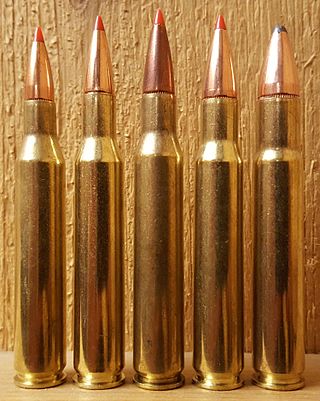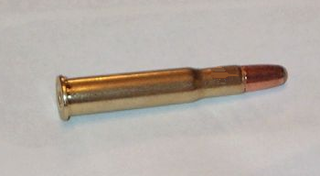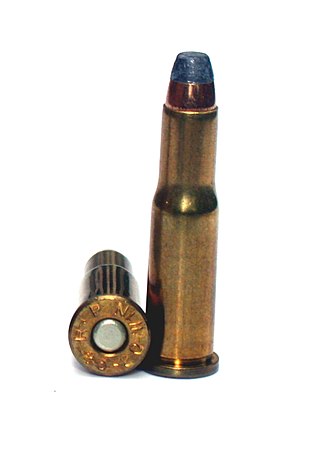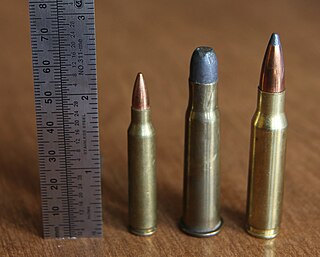Winchester rifle is a comprehensive term describing a series of lever action repeating rifles manufactured by the Winchester Repeating Arms Company. Developed from the 1860 Henry rifle, Winchester rifles were among the earliest repeaters. The Model 1873 was particularly successful, being marketed by the manufacturer as "The Gun That Won the West".

The .44 Remington Magnum, also known as .44 Magnum or 10.9x33mmR, is a rimmed, large-bore cartridge originally designed for revolvers and quickly adopted for carbines and rifles. Despite the ".44" designation, guns chambered for the .44 Magnum round, its parent case, the .44 Special, and its parent case, the .44 Russian all use 0.429 in (10.9 mm) diameter bullets. The .44 Magnum is based on the .44 Special case but lengthened and loaded to higher pressures for greater velocity and energy.

The .32-20 Winchester, also known as .32 WCF , was the first small-game lever-action cartridge that Winchester produced. It was initially introduced as a black-powder cartridge in 1882 for small-game, varmint hunting, and deer. Colt produced a single-action revolver chambered for this cartridge a few years later.

The .44-40 Winchester, also known as .44 Winchester, .44 WCF, and .44 Largo, was introduced in 1873 by the Winchester Repeating Arms Company. It was the first metallic centerfire cartridge manufactured by Winchester, and was promoted as the standard chambering for the new Winchester Model 1873 rifle. As both a rifle and a handgun caliber, the cartridge soon became widely popular, so much so that the Winchester Model 1873 rifle became known as "The gun that won the West."

The .270 Winchester is a rifle cartridge developed by Winchester Repeating Arms Company in 1923 and it was unveiled in 1925 as a chambering for their bolt-action Model 54 to become arguably the flattest shooting cartridge of its day, only competing with the .300 Holland & Holland Magnum, also introduced in the same year.
Marlin Firearms Co. is an American manufacturer of semi-automatic, lever-action, and bolt-action rifles. In the past, the company, now based in Madison, North Carolina, and formerly based in North Haven, Connecticut, made shotguns, derringers, and revolvers. Marlin owned the firearm manufacturer H&R Firearms. In 2007, Remington Arms, part of the Remington Outdoor Company, acquired Marlin Firearms. Remington produced Marlin-brand firearms at its Kentucky and New York manufacturing facilities. In 2020, Sturm, Ruger & Co. bought the Marlin business from bankrupt Remington Outdoor Company.

The .30-30 Winchester cartridge was first marketed for the Winchester Model 1894 lever-action rifle in 1895. The .30-30, as it is most commonly known, along with the .25-35 Winchester were offered that year as the United States' first small-bore sporting rifle cartridges designed for smokeless powder. Since its introduction, it has been surpassed by many cartridges in the long-range shooting attributes of speed, energy, and trajectory, yet remains in widespread use because of its practical effectiveness in forested hunting situations.
The Winchester Model 71 was a lever-action rifle introduced in 1935 and discontinued in 1958.

The .444 Marlin (10.9×57mmR) is a rifle cartridge designed in 1964 by Marlin Firearms and Remington Arms. It was designed to fill in a gap left by the older .45-70 when that cartridge was not available in any new lever-action rifles; at the time it was the largest lever-action cartridge available. The .444 resembles a lengthened .44 Magnum and provides a significant increase in velocity. It is usually used in the Marlin 444 lever-action rifle. Currently, Marlin, who is now owned by Ruger Firearms, does not offer the .444 chambering in any of their rifles. It remains to be seen when or if they will bring the chambering back into production.
The Marlin Model 336 is a lever-action rifle and carbine made by Marlin Firearms. Since its introduction in 1948, it has been offered in a number of different calibers and barrel lengths, but is commonly chambered in .30-30 Winchester or .35 Remington, using a 20- or 24-inch barrel. Currently, the model with a 24-inch barrel is only available in .30-30 Winchester. The Model 336 is now back in production as of March 27, 2023.

The .25-20 Winchester, or WCF, was developed around 1895 for the Winchester Model 1892 lever action rifle. It was based on necking down the .32-20 Winchester. In the early 20th century, it was a popular small game and varmint round, developing around 1,460 ft/s with 86-grain bullets. But two years earlier Marlin Firearms Co. had already necked down the .32-20 Winchester, and called it the .25-20 Marlin. It was first chambered in Model 1889 lever action Marlins long before Winchester did the same thing and put their name on the .25-20.

The .303 Savage is a rimmed, .30 caliber rifle cartridge developed by the Savage Arms Company in 1894 which was designed as a short action cartridge for their Savage Model 1895 later 1899 hammerless lever-action rifle. The cartridge was designed for smokeless powder at a time when black-powder cartridges were still popular. The .303 Savage round was ballistically superior to the .30-30, but only marginally. The .303 Savage remained popular through the 1930s. Savage produced a half dozen loads for it. With its 190-grain loading, it was used on such animals as deer and moose.
The Winchester Model 1895 is an American lever-action repeating firearm developed and manufactured by the Winchester Repeating Arms Company in the late 19th century, chambered for a number of full-size military and hunting cartridges such as 7.62×54mmR, .303 British, .30-03, .30 Army, .30-06, .35 Winchester, .38-72 Winchester, .40-72 Winchester and .405 Winchester.
The .35 Winchester cartridge was created in 1903 by the Winchester Repeating Arms Company for use in the Winchester Model 1895 lever-action rifle, and was also available in the bolt action Remington-Lee, or the Model E-10 Factory Sporter Ross Rifle in Canada.

The .33 Winchester Center Fire is a centerfire rifle cartridge designed and produced from 1902 to 1940 by Winchester Repeating Arms Company for their Model 1886 lever-action rifle.

The .401 Winchester Self-Loading is an American rifle cartridge.
The .38-72 Winchester, also known as .38-72 WCF is a rimmed, bottleneck centerfire rifle cartridge introduced in 1895 for the Winchester 1895 lever-action rifle.

The .40-72 Winchester, also known as .40-72 WCF is a centerfire straight-walled rifle cartridge designed for black powder rather than smokeless powder. It was introduced in 1895 for the Winchester 1895 lever-action rifle.

The .45-75 WinchesterCentennial is a centerfire rifle cartridge developed in 1876 for the newly designed Winchester Model 1876 Centennial lever-action rifle. Winchester Repeating Arms Company introduced the rifle and cartridge at the United States Centennial Exposition. The Model 1876 rifle used an enlarged version of the famous Winchester Model 1873 action to offer a lever-action repeating rifle using cartridges suitable for big-game hunting. The cartridge and rifle enjoyed brief popularity with Gilded Age American hunters including Theodore Roosevelt, and was issued to the Canadian North-West Mounted Police and to Texas Rangers.

The .40-60 Winchester is a rimmed, bottlenecked centerfire rifle cartridge designed for use in lever-action rifles by Winchester Repeating Arms Company in 1884.
















